Each question given below contains arguments of three sentences each. Choose the set in which the third statement is a logical conclusion of the first two.
| 1.
A: No flowers are red. Roses are red. Roses are not flowers. |
Easy |
| a. B only b. A only c. Both A and C d. All of these |
View Answer
Answer: Option b
Explanation:
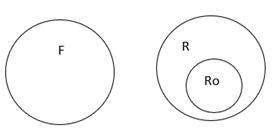
F=Flowers, Ro=Roses, R=Red
If no flowers are Red and Rose is Red, then Rose cannot be a flower.
Note that the world of syllogisms may not conform to the mental associations that we normally assign to things.
| 2.
A: Only bulbs are candles. Candles are made of wax. Bulbs are made of wax. |
Easy |
| a. Both A & C b. B only c. C only d. all of these |
View Answer
Answer: Option c
Explanation:

M=Mortar, B=Brick, L=Log
As seen from the Venn Diagram, some Logs are Mortars.
Each of the following questions consists of five statements followed by options consisting of three statements put together in a specific order. Choose the option which indicates a valid argument, that is, where the third statement is a conclusion drawn from the preceding two statements.
| 3.
A: All software companies employ knowledge workers. |
Easy |
| a. ABC b. ACB c. CDB d. ACE |
View Answer
Answer: Option b
Explanation:
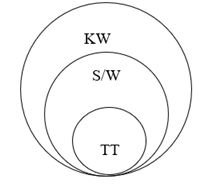
KW: Knowledge Workers, S/W: Software Company, TT: TechnoTech
All software companies employ knowledge workers. Techno Tech is a software company. This means that Techno Tech employs knowledge workers.
| 4.
A: Traffic congestion increases carbon monoxide in the environment. |
Easy |
| a. CBA b. BDE c. CDE d. BAC |
View Answer
Answer: Option d
Explanation:
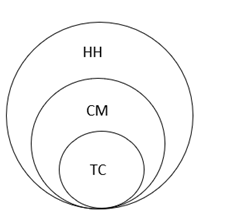
HH: Hazardous to Health, CM: Increase in Carbon Monoxide, TC: Traffic Congestion
Increase in carbon monoxide is hazardous to health. Traffic congestion increases carbon monoxide in the environment. This clearly indicates that traffic congestion is hazardous to health.
The following question has a main statement followed by four statements labelled A, B, C and D. Choose the ordered pair of statements where the first statement implies the second and the two statements are logically consistent with the main statement.
| 5. Either the orangutan is not angry, or he frowns upon the world. A: The orangutan frowns upon the world. B: The orangutan is not angry. C: The orangutan does not frown upon the world. D: The orangutan is angry. |
Easy |
| a. CB only b. DA only c. AB only d. CB & DA |
View Answer
Answer: Option d
Explanation:
Either X or Y.
A: The orangutan frowns upon the world. (Y)
B: The orangutan is not angry. (X)
C: The orangutan does not frown upon the world. (not Y)
D: The orangutan is angry. (not X)
There are only 4 valid placements:
i. X, not Y — BC
ii. Not Y, X — CB
iii. Y, not X — AD
iv. Not X, Y — DA
CB & DA are valid placements.
The question below contains arguments of three sentences each. Choose the set in which the third statement is a logical conclusion of the first two.
| 6.
A: Some trees have branches. All banks have branches. All banks are trees. |
Medium |
| a. C only b. B only c. Both A & C d. All of these |
View Answer
Answer: Option a
Explanation:
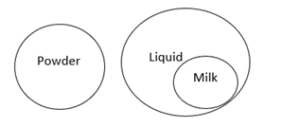
Only statement C is correct.
The question below consists of five statements followed by options consisting of three statements put together in a specific order. Choose the option which indicates a valid argument, that is, where the third statement is a conclusion drawn from the preceding two statements.
| 7.
A: Ant eaters like ants. |
Medium |
| a. ADC b. DCA c. ABE d. ACD |
View Answer
Answer: Option b
Explanation:
Balram likes ants. Balram is an ant eater. Therefore, Ant eaters like ants. Statement A is the direct inference drawn from Statements D & C.
In the question below, the main statement is followed by four sentences. Select the pair of sentences that relate logically to the given statement.
| 8. Ram gets a swollen nose whenever he eats hamburgers. A: Ram gets a swollen nose. B: Ram does not eat hamburgers. C: Ram does not get a swollen nose. D: Ram eats hamburgers. |
Medium |
| a. AB b. DC c. AC d. None of these |
View Answer
Answer: Option d
Explanation:
Whenever X, then Y
OR
If X, then Y.
There are only 2 valid sequences in this case:
i. Fulfillment of condition, occurrence of consequence. — DA
ii. Non-occurrence of the consequence, non-fulfillment of the condition. — BC
Neither DA nor BC are listed in the choices given in the question. So, the answer is None of these.
The question below contains arguments of three sentences each. Choose the set in which the third statement is a logical conclusion of the first two.
| 9.
A: Some Xs are Ps. Some Ps are Ys. Some Xs are Ys. |
Difficult |
| a. A & D only b. D only c. C only d. None of these |
View Answer
Answer: Option c
Explanation:
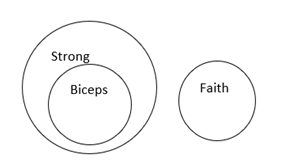
strong and faith have no association, hence faith and biceps will have no relation at all.
The following question consists of five or six statements followed by options consisting of three statements put together in a specific order. Choose the option which indicates a valid argument, that is, where the third statement is a conclusion drawn from the preceding two statements.
| 10.
A: MBAs are in great demand. |
Difficult |
| a. ABE b. ECD c. EBA d. AEB |
View Answer
Answer: Option d
Explanation:

Clearly, statement B is the direct conclusion drawn from statements A & E.
